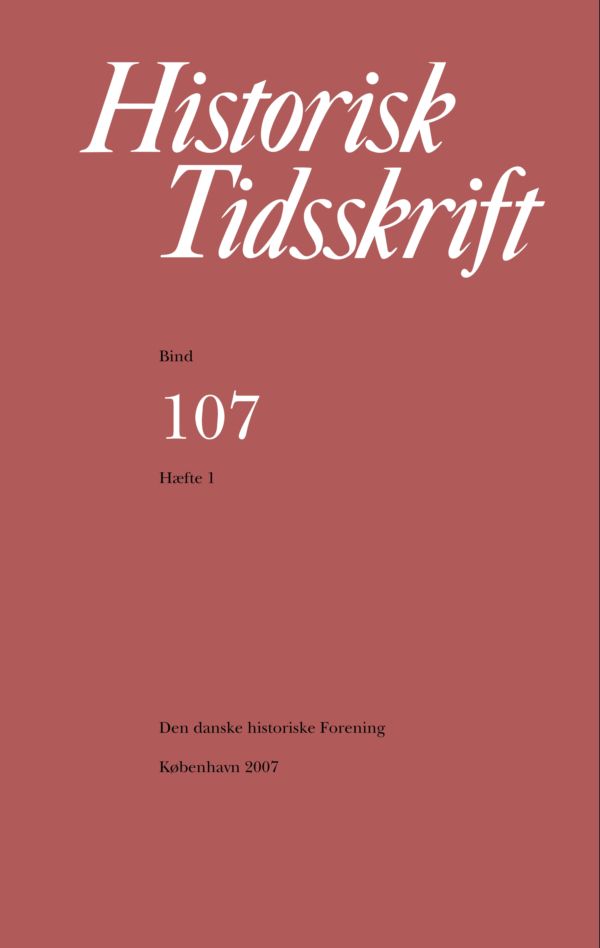Faghæftet »Historie 1984« og paradigmeskiftet i historiedidaktikken
Resumé
The Instruction Guide “History 1984” And the Paradigm Shift in Historical Didactics In 1982 Bertel Haarder, the Minister of Education in the new Danish conservative-liberal government, established a curriculum committee on history teaching in the municipal primary schools, a move that amounted to a demonstrative break with the semi-Marxist Instruction Guide in History 1981, which had gone into effect the previous year, and therewith with its ’presentistic’ key concepts: ’the view of history’ and ’types of society’ (cf. the summary of my previous article in the present journal, 106:1, p. 167). The chief innovation of the 1984 guide that emerged from Haarder’s committee lay in the section on curriculum entitled “Central Areas of Knowledge” (appended to the present article), which in listing main themes of Danish history, such as the Reformation, the Absolute Monarchy, the Agricultural Reforms and the Constitutional Struggle, represented a potential canon, despite its formal status as only a guideline.The present article evaluates the extent to which Haarder’s pronouncements regarding the intentions behind the work of the committee at its inception in effect established a new agenda. The outcome, History 1984, can be read in part within the interpretive framework that developed during the prior debate. The new post-modern multiculturalism none the less did have some impact on the process.The reinvigorated debate on didactics developed between two new poles: Haarder’s conception of how to teach history in the schools collided head on with the new didactics of historical consciousness, whose general bearings can be summed up in six key terms:1) Presentism. In the more radical form of this concept chronology is oriented towards the present and the future.2) Identity. This is directed towards the future, utopian in character and released from the past.3) History. In substance the subject is a variant of social studies with a time perspective. Its approach is activist and politically formative, geared to participation in a democratic society.4) Multiculturalism. As opposed to a culture subject along traditional lines, with an obligation to transfer knowledge and the cultural heritage, it aims at cultural emancipation.5) Creativity. The emphasis is not on cultural heritage, but on the pupil’s skills as an active constructor in the context of a productive form of teaching history. The pupil, for instance, is asked to create a fictional and counterfactual historical narrative. The thrust of this form is to sever history as a school subject from its foundation in the scholarly discipline – transmitted with due regard to the pupil’s maturity.6) Personality formation. The creative element goes beyond intellectual knowledge by involving the pupil’s feelings and imagination, adapting itself in this regard to the so-called new type of affective pupil.In the first part of the study Haarder’s conception of teaching history is reviewed in relation to these six key concepts along with the views of some Grundtvigian educators and theologians who partially shared his opinions. Their views, expounded in a series of manifestos, had a considerable impact on the course of the debate. This is followed by a description of the opinions expressed by leading members of the ministerial curriculum committee prior to their appointment to the committee, while its work was in progress, and not least when it was finished and the individual members stepped forward and presented and interpreted its results. This first part of the study is completed by a treatment of how the outcome was received by the public and what effect it had on the internal professional debate centred in the Danish Association of History Teachers.The second part of the article begins with a treatment of the German sociologist and professor of educational science Thomas Ziehe and his ideas on school education and social analysis. His focus on cultural liberation and the emancipation of culture from traditionalism can be seen as a general theoretical current that contributed to the inspirational basis of the emerging didactics of historical consciousness. An analysis follows, along the lines of the six point scheme mentioned above, of their gradual development, beginning with the pupil-centred critique of the excessively adult and professional approach allegedly inherent in the politically radical instruction guide History 1981, and ending with the fully developed paradigm in 1983. In the later phases the emphasis lay on the aspects of fictional creativity and personality formation. The article concludes with a summary of the similarities and differences between the two parallel debates on curriculum and historical consciousness.It is difficult to say who emerged as the winner after the publication of the instruction guide. The status of the specified subject list as a guideline, not a mandatory catalogue, was seen by some as an open invitation to interpretation. Others emphasized, to the contrary, that the section on “Central Areas of Knowledge” none the less was an important directional signal. But the most important fault line at the beginning and in the middle of the 1980s was the fact that narration and historical fiction became topics of debate. The new didactics of historical consciousness broadly prevailed in the question of formulating the subject goals of history in 1994 and the instruction guide of 1995, which finally laid Bertel Haarder’s History 1984 to rest, and therewith also the 1975 subject goals of Ritt Bjerregaard, minister of education in an earlier Social Democratic government.Translated by Michael WolfeDownloads
Publiceret
Citation/Eksport
Nummer
Sektion
Licens
Ophavsret til bidrag i Historisk Tidsskrift tilhører forfatterne og Den danske historiske Forening som udgiver af Historisk Tidsskrift. For illustrationer gælder den ophavsret, som står anført i billedteksten. Ophavsretslovens almindelige bestemmelser gælder, hvilket vil sige, at ophavsretten gælder i 70 år efter forfatterens død. Bidrag i Historisk Tidsskrift må derfor, med forbehold for en ”moving wall” på tre år, frit downloades, læses, gemmes, anvendes og citeres (med kildeangivelse) i privat og videnskabelig sammenhæng, men de må ikke helt eller delvis genudgives af tredjepart, heller ikke i redigeret form, uden tilladelse fra forfatterne og Den danske historiske Forening. Henvendelse skal i så fald rettes til Historisk Tidsskrifts redaktion på histtid@hum.ku.dk.





